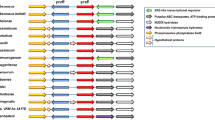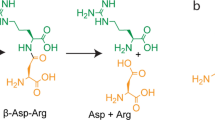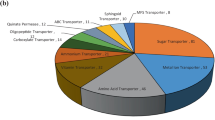Abstract
By data mining in the sequence of the Corynebacterium glutamicum ATCC 13032 genome, six putative mycolyltransferase genes were identified that code for proteins with similarity to the N-terminal domain of the mycolic acid transferase PS1 of the related C. glutamicum strain ATCC 17965. The genes identified were designated cop1, cmt1, cmt2, cmt3, cmt4, and cmt5 (cmt from corynebacterium mycolyltransferases). cop1 encodes a protein of 657 amino acids, which is larger than the proteins encoded by the cmt genes with 365, 341, 483, 483, and 411 amino acids. Using bioinformatics tools, it was shown that all six gene products are equipped with signal peptides and esterase domains. Proteome analyses of the cell envelope of C. glutamicum ATCC 13032 resulted in identification of the proteins Cop1, Cmt1, Cmt2, and Cmt4. All six mycolyltransferase genes were used for mutational analysis. cmt4 could not be mutated and is considered to be essential. cop1 was found to play an additional role in cell shape formation. A triple mutant carrying mutations in cop1, cmt1, and cmt2 aggregated when cultivated in MM1 liquid medium. This mutant was also no longer able to synthesize trehalose dicorynomycolate (TDCM). Since single and double mutants of the genes cop1, cmt1, and cmt2 could form TDCM, it is concluded that the three genes, cop1, cmt1, and cmt2, are involved in TDCM biosynthesis. The presence of the putative esterase domain makes it highly possible that cop1, cmt1, and cmt2 encode enzymes synthesizing TDCM from trehalose monocorynomycolate.





Similar content being viewed by others
References
Altschul SF, Madden TL, Schaffer AA, Zhang J, Zhang Z, Miller W, Lipman DJ (1997) Gapped BLAST and PSI-BLAST: a new generation of protein database search programs. Nucleic Acids Res 25:3389–3402
Alshamaony L, Goodfellow M, Minnikin DE (1976) Free mycolic acids as a criteria in the classification of Nocardia and the 'rhodochrous' complex. J Gen Microbiol 92:188–199
Barksdale, L (1970) Corynebacterium diphteriae and its relatives. Bacteriol Rev 4:378–422.
Belsisle JT, Vissa VD, Sievert T, Takayama K, Brennan PJ, Besra GS (1997) Role of the major Antigen of Mycobacterium tuberculosis in cell wall biogenesis. Science 276:1420–1422
Blanchard JS (1996) Molecular mechanisms of drug resistance in Mycobacterium tuberculosis. Annu Rev Biochem 65: 215–239
Bonnassie S, Oreglia J, Trautwetter A, Sicard AM (1990) Isolation and chararcterization of a restriction and modification deficient mutant of Brevibacterium lactofermentum. FEMS Microbiol Lett 60:143–146
Brennan PJ, Nikaido H (1995) The envelope of mycobacteria. Annu Rev Biochem 64: 29–63
Chami M, Bayan N, Peyret JL, Gulik-Krzywicki T, Leblon G, Shechter E (1997) The S-layer protein of Corynebacterium glutamicum is anchored to the cell wall by its C-terminal hydrophobic domain. Mol Microbiol 23: 482–492
Chun J, Kang S-O, Hah YC, Goodfellow M (1996) Phylogeny of mycolic acid-containing actinomycetes. J Indust Microbiol 17:205–213
Collins MD, Goodfellow M, Minnikin DE (1982) A survey of the structures of mycolic acids in Corynebacterium and related taxa. J Gen Microbiol 128:129–149.
Daffé M, Draper P (1998) The envelope layers of mycobacteria with reference to their pathogenicity. Adv Microb Physiol 39:131–203
Dittmer JFC, Lester RL (1964) A simple specific spray for the detection of phopholipids on thin layer chromatography. J Lipid Res 5:126–127
Draper P (1998) The outer parts of the mycobacterial envelope as permeability barriers. Front Biosci 3: D1253-D1216
Eggeling L, Sahm H (2001) The cell wall barrier of Corynebacterium glutamicum and amino acid efflux. J Biosci Bioeng 92:201–213
Felsenstein J (1992) Estimating effective population size from samples of sequences: a bootstrap Monte Carlo integration method. Genet Res 60: 209–220
George KM, Yuan Y, Sherman DR, Barry 3rd CE (1995) The biosynthesis of cyclopropanated mycolic acids in Mycobacterium tuberculosis. Identification and functional analysis of CMAS-2. J Biol Chem 270:27292–27298
Grant SGN, Jesse J, Bloom FR, Hanahan D (1990) Differential plasmid rescue from transgenic mouse DNAs into Escherichia coli methylation-restriction mutants. Proc Natl Acad Sci 87: 4645–4649
Haynes JA, Britz ML (1989) Electrotransformation of Brevibacterium lactorfermentum and Corynebacterium glutamicum: growth in Tween 80 increases transformation frequencies. FEMS Microbiol Lett 61: 329–334
Heijne von G (1990) The signal peptide. J Membr Biol 115:195–201
Henzel WJ, Billeci TM, Stults JT, Wong SC, Grimley C, Watanabe C (1993) Identifying proteins from two-dimensional gels by molecular mass searching of peptide fragments in protein sequence databases. Proc Natl Acad Sci USA 90:5011–5015
Hermann T, Pfefferle W, Baumann C, Busker E, Schaffer S, Bott M, Sahm H, Dusch N, Kalinowski J, Pühler A, Bendt AK, Krämer R, Burkovski A (2001) Proteome analysis of Corynebacterium glutamicum. Electrophoresis 22:1712–1723
Higgins DG, Bleasby AJ, Fuchs R (1992) CLUSTAL V: improved software for multiple sequence alignment. Comput Appl Biosci 8: 189–191
Horton RM (1995) PCR-mediated recombination and mutagenesis: SOEing together tailor-made genes. Mol Biotechnol 3: 93–99
Jackson M, Raynaud C, Lenéelle MA, Guilhot C, Laurent-Winter C, Ensergueix D, Gicquel B, Daffé M (1999) Inactivation of the antigen 85C gene profoundly affects the mycolate content and alters the permeability of the Mycobacterium tuberculosis cell envelope. Mol Microbiol 31: 1573–1587
Joliff G, Mathieu L, Hahn V, Bayan N, Duchiron F, Renaud M, Shechter E, Leblon G (1992) Cloning and nucleotide sequence of the csp1 gene encoding PS1, one of the two major secreted proteins of Corynebacterium glutamicum: the deduced N-terminal region of PS1 is similar to the Mycobacterium antigen 85 complex. Mol Microbiol 6: 2349–2362
Kalinowski J, Bathe B, Bischoff N, Bott M, Burkovski A, DuschN, Eggeling L, Eikmanns BJ, Gaigalat L, Goesmann A, Hartmann M, Huthmacher K, Krämer R, Linke B, McHardy AC, Meyer F, Möckel B, Pfefferle W, Pühler A, Rey DA, Rückert C, Sahm H, Wendisch VF, Wiegräbe I, Tauch A (2003) The complete Corynebacterium glutamicum ATCC 13032 genome sequence and its impact on the production of l-aspartate-derived amino acids and vitamins. J Biotechnol (in press)
Kilburn JO, Takayama K, Amstrong EL (1982) Synthesis of trehalose dimycolate (cord factor) by a cell-free system of Mycobacterium smegmatis. Biochem Biophys Res Commun 108:132–139
Krämer R (1994) Secretion of amino acids by bacteria: physiology and mechanism. FEMS Microbiol Rev 13:75–93
Laemmli UK (1970) Cleavage of structural proteins during the assembly of the head of bacteriophage T4. Nature 227:680–685
Leuchtenberger W (1996) Amino acids: technical production and use. In: Rehm HJ, Reed G, Puehler A, Stadler P (eds) Biotechnology. VCH, Weinheim Germany, pp 465–502
Liu J, Barry 3rd CE, Besra GS, Nikaido H (1996) Mycolic acid structure determines the fluidity of the mycobacterial cell wall. J Biol Chem 271:29545–29551
Marchler-Bauer A, Panchenko AR, Shoemaker BA, Thiessen PA, Geer LY, Bryant SH (2002) CDD: a database of conserved domain alignments with links to domain three-dimensional structure. Nucleic Acid Res 30: 281–283
Marienfeld S, Uhlemann E-M, Schmid R, Krämer R, and Burkovski A (1997) Ultrastructure of the Corynebacterium glutamicum cell wall. Antonie van Leeuwenhoek 72:291–297
Meyer D, Goesmann A, McHardy AC, Bartels D, Bekel T, Clausen J, Kalinowski J, Linke B, Rupp O, Giegerich R, and Pühler A (2003) GenDB-an open source genome annotation system for prokaryotic genomes. Nucleic Acid Res 31:2187–2195
Minnikin DE (1982) Complex lipids: Their chemistry, biosynthesis and roles. In: Ratledge C, Stanford J (eds) The biology of mycobacteria, vol 1. Academic, London, pp 98–184
Minnikin DE, Goodfellow M (1980) Lipid composition in the classification and identification of acid-fast bacteria. In: Goodfellow M, Board RG (eds) Microbiological classification and identification. Academic, London, pp 189–239
Minnikin DE, O'Donnel AG (1984) Actinomycetes envelope lipid and peptidoglycan composition. In: Goodfellow M, Mordarski M, Williams ST (eds) The Biology of Actinomycetes. Academic Press, London pp 337–388
Minnikin DE, Goodfellow M, O'Donnel AG (1978) Lipid composition in the classification and identification of coryneform and related taxa. In: Bousfield IJ, AG Calley (eds) Coryneform Bacteria. Academic Press, London, pp 85–160
Nielsen H, Engelbrecht J, Brunak S, von Heijne G (1997) A neural network method for identification of prokaryotic and eukaryotic signal peptides and prediction of their cleavage sites. Int J Neural Syst 8: 581–599
Perkins DN, Pappin DJ, Creasy DM, Cottrell JS (1999) Probability-based protein identification by searching sequence databases using mass spectrometry data. Electrophoresis 20:3551–3567
Peyret JL, Bayan M, Joliff G, Gulik-Krzywicki T, Mathieu L, Shechter E, Leblon G (1993) Characterization of the cspB gene encoding PS2, an ordered surface-layer protein in Corynebacterium glutamicum. Mol Microbiol 9:97–109
Philipp WJ, Poulet S, Eiglmeier K, Pascopella L, Balasubramanian V, Heym B, Bergh S, Bloom BR, Jacops WR Jr, Cole ST (1996) An integrated map of the genome of the tubercle bacillus, Mycobycterium tuberculosis H37Rv, and comparison with Mycobacterium leprae. Proc Natl Acad Sci USA 93:3132–3137
Puech V, Bayan N, Salim K, Leblon G, Daffé M (2000) Characterization of the in vivo acceptors of the mycolyl residues transferred by the corynebacterial PS1 and the related mycobacterial antigen 85. Mol Microbiol 35:1026–1041
Puech V, Chami M, Lemassu A, Lanéelle M-A, Schiffler B, Gounon P, Bayan N, Benz R, Daffé M (2001) Structure of the cell envelope of corynebacteria: importance of the non-covalently bound lipids in the formation of the cell wall permeability barrier and fracture plane. Microbiology 147:1365–1382
Puech V, Guilhot C, Perez E, Tropis M, Armitige LY, Gicquel B, Daffé M, (2002) Evidence for a partial redundancy of the fibronectin-binding proteins for the transfer of mycolyl residues onto the cell wall arabinogalactan termini of Mycobacterium tuberculosis. Mol Microbiol 44:1109–1122
Richter W, Hänel F, Hilliger M (1985) Freeze-fracture observations of Corynebacterium glutamicum: the occurrence of an outer-membrane like structure and the influence of temperature on the cytoplasmatic membrane. J Basic Microbiol 25:527–536
Ronning DR, Klabunde T, Besra GS, Vissa VD, Belisle JT, Sacchettini JC, (2000) Crystal structure of the secreted form of antigen 85C reveals potential targets for mycobacterial drugs and vaccines. Nat Struct Biol 72: 141–146
Saitou M, Nei M (1987) The neighbor-joining method: a new method for reconstructing phylogenetic trees. Mol Biol Evol 4:406–425
Sambrook J, Fritsch EF, Maniatis T (1989) Molecular cloning: a laboratory manual, 2nd edn. Cold Spring Harbor Laboratory, Cold Spring Harbor, New York
Sathyamoorthy N, Takayama T (1987) Purification and characterization of a novel mycolic acid exchange enzyme from Mycobacterium tuberculosis. J Biol Chem 262:13417–13423
Schäfer A, Tauch A, Jäger W, Kalinowski J, Thierbach G, Pühler A (1994) Small mobilizable multi-purpose cloning vectors derived from the Escherichia coli plasmids pK18 and pK19: Selection of defined deletions in the chromosome of Corynebacterium glutamicum. Gene 145:69–7
Southern EMR, Anand R, Brown WRA, Fletcher DS (1987) A model for the separation of large DNA molecules by crossed field gel electrophoresis. Nucleic Acids Res 15:5925–5942
Suggs SV, Hirose T, Miyake T, Kawashima EH, Johnson MJ, Itakura K, Wallace RB (1981) Use of synthetic oligodeoxyribonucleotides for the isolation of specific cloned DNA sequences. In: Brown DD, Fox CF (eds) Developemental biology using purified genes. Academic , New York, pp 683–693
Tauch A, Kassing F, Kalinowski J, Pühler A (1995) The Corynebacterium xerosis composite transposon Tn 5432 consists of two identical insertion sequences, designated IS 1249, flanking the erythromycin resistance gene ermCX. Plasmid 34:119–131
Tauch A, Kirchner O, Löffler B, Götker S, Pühler A, Kalinowski J, (2002) Efficient electrotransformation of Corynebacterium diphteriae with a mini-replicon derived from Corynebacterium glutamicum plasmid pGA1. Curr Microbiol 45:362–367
Thompson JD, Higgins DG, Gibson TJ (1994) CLUSTAL W: improving the sensitivity of progressive multiple alignment through sequence weighting, position-specific gap penalties and weight matrix choice. Nucleic Acids Res 22:4673–4680
Tjalsma H, Bolhuis A, Jongbloed H, Bron S, van Dijl JM (2000) Signal peptide-dependent protein transport in Bacillus subtilis: a genome-based survey of the secretome. Microbiol Mol Biol Rev 64:515–547
Wiker HG, Harboe M, Nagai S, Bennedsen J (1990) Quantitative and qualitative studies on the major extracellular antigen of Mycobacterium tuberculosis H37Rv and Mycobacterium bovis BCG. Am Rev Respir Dis 141:830–838
Wohlleben W, Muth G, Kalinowski J (1993) Genetic engineering of gram positive bacteria. In: Rehm HJ, Reed G, Pühler A, Stadler P (eds) Biotechnology. VCH, Weinheim, Germany, pp 457–505
Young LJ, Lee EY, To HA, Bookstein R, Shew JY, Donoso LA, Sery T, Giblin M, Shields JA, Lee WH (1988) Human Esterase D gene: complete cDNA sequence, genomic structure, and application in the genetic diagnosis of human retinoblastoma. Hum Genet 79:137–141
Acknowledgements
We thank Degussa AG for financial support. S.B. acknowledges a grant from Graduiertenkolleg GRK 35/3–98 funded by the Deutsche Forschungsgemeinschaft (DFG).
Author information
Authors and Affiliations
Corresponding author
Rights and permissions
About this article
Cite this article
Brand, S., Niehaus, K., Pühler, A. et al. Identification and functional analysis of six mycolyltransferase genes of Corynebacterium glutamicum ATCC 13032: the genes cop1, cmt1, and cmt2 can replace each other in the synthesis of trehalose dicorynomycolate, a component of the mycolic acid layer of the cell envelope. Arch Microbiol 180, 33–44 (2003). https://doi.org/10.1007/s00203-003-0556-1
Received:
Revised:
Accepted:
Published:
Issue Date:
DOI: https://doi.org/10.1007/s00203-003-0556-1




